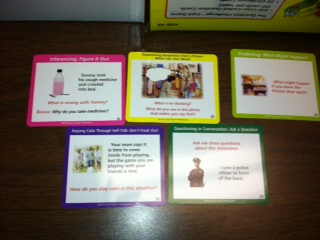I was fortunate enough to be provided by Super Duper “The
Question Challenge Card Game” and “The Question Challenge Card Game Fun Sheets”
book. Just note that the opinions are
all mine!
Do you have students working on higher level questioning
skills? This activity is just for
you! You can use this product with
students in all grade levels by adapting it if necessary. This product reinforces expressive and
receptive skills in 10 different areas: inferencing, understanding sarcasm,
determining perspective, staying calm through self-talk, stating opinions,
predicting, intonation and body language, cognitive flexibility, social
encouragement, and questioning in conversation.
As you can tell, these skills can address skills that correlate with the
common core standards for language arts as well as addressing pragmatic/social
skills.
Common Core Standards you can address (you can use these for
writing lesson plans or rationales for using this product in speech and
language sessions):
·
Understand question words (who, what, where,
when, why, how).
·
Drawing conclusions from a story or text.
·
Distinguish the literal and non-literal meaning
of words and phrases in context.
·
As questions about a text; ask questions to
check for understanding.
·
Recount an experience with appropriate facts and
relevant, descriptive details.
·
Engage effectively in a range of collaborative
discussions with diverse partners, building on other’s ideas and expressing
their own clearly. Provide reasons to
support an opinion.
·
Demonstrate understanding of figurative
language.
·
Pose specific topic related questions during
conversation and make comments that contribute to the discussion
·
Report on a topic or present an opinion, sequencing
ideas logically and using appropriate facts and relevant and descriptive
details to support main idea or themes.
·
Produce simple, compound, and complex sentences
using appropriate subject-verb agreement.
The game: it comes with an electronic spinner, bingo chips,
challenge cards, and cards targeting the various areas listed above. You can play three ways:
·
You can have student select a challenge card to
determine who is going and how many questions they will answer. If answer is appropriate, the student will spin
the spinner and receive that amount of chips.
You can decide when the game will end, when chips run out or time runs
out. Whoever has the most chips wins!
·
You can deal seven question cards to each
student. Student can spin the spinner
and answer that amount of cards. If they
answer correctly, they can place the card face down. First player to answer all cards and get rid
of them is the winner.
·
You can also use the game cards with any other
Super Duper game (Pirate Talk, Chipper Chat, etc.) or general board game
(Candyland, Chutes and Ladders, Jenga, etc.).
I chose to play by giving each student a cup. They selected the challenge card to follow
directions and know what to do. I chose
an area to work on for the group (or if I had students with mixed goals, I gave
a different target skill to each, GREAT for differentiated learning!). When the student responded correctly, they
spun to get their chips. I put a timer
on my iPad for 15 minutes since I did not want the game to last the whole session. Once the timer went off, we counted our chips
to see who won! I followed up the
activity with either a worksheet from the fun sheets book or a game on my iPad
that went with the concept we were learning (i.e. Understanding Inferences or
Let’s Predict from SuperDuper, Garfield’s fact & opinion, Conversation
Builder, Question Builder, Autism and PDD Reasoning, and more!).
Fun Sheets Book:
This is a great book for follow-up activities from the
game. You can use it right after, in a
follow up session, or give as homework.
The pages provide a variety of activities: matching games, word
searches, crossword puzzles, game boards, cube rolls, word associations, memory
games, story-writing activities, drawing activities and more! The book comes with an answer key and CD for
easy printing (no need to run to the photocopy machine!).
I liked using this book because it allowed me to assess the
students work independently. The game
provided a “drill” method and the book allowed for assessment of comprehension
and carryover. The pages were motivating
for my students. They did not realize
they were still learning! The activities
correlate so well with the game that it was a great way to practice the learned
skill. I ran and made some copies of
favorites from each target skill and kept it in the game box so they are ready
to go!
I definitely recommend this game and book for all speech
pathologists working with school aged children.
It addresses so many skills that are important for development and
correlate with standards expected of them.
So many language delayed students have difficulty with these skills and
this game is a motivating way to work in it.
The fact that you can play and use these cards in a variety of ways, you
can keep taking this game out and the students won’t get sick of it! I am always looking for games that when an
administrator walks by, they won’t question me on why we are playing
again. This game targets so many
language goals and standards (as I mentioned above), I don’t have to make up a
rationale! I know most school-based
therapists are probably filling out budget request forms. One should definitely consider ordering these
two products! You will not regret it!





No comments:
Post a Comment